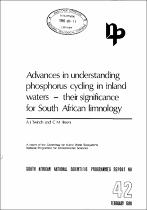 ResearchSpace
ResearchSpace
Advances in understanding phosphorus cycling in inland waters - Their significance for South African limnology
JavaScript is disabled for your browser. Some features of this site may not work without it.
- ResearchSpace
- →
- Archives collection
- →
- Open Access Reports
- →
- View Item
| dc.contributor.author |
Twinch, AJ

|
|
| dc.contributor.author |
Breen, CM

|
|
| dc.date.accessioned | 2008-03-25T09:48:52Z | |
| dc.date.available | 2008-03-25T09:48:52Z | |
| dc.date.issued | 1980-02 | |
| dc.identifier.citation | Twnch, AJ and Breen CM. 1980. Advances in understanding phosphorus cycling in inland waters - Their significance for South African limnology. SANSP Report 42, Feb 1980, pp 27 | en |
| dc.identifier.isbn | 0 7988 1757 7 | |
| dc.identifier.uri | http://hdl.handle.net/10204/2205 | |
| dc.description.abstract | The definitions of the different phosphorus compound fractions present in inland waters are reviewed and the limitations of the definitions discussed. The development of models of phosphorus cycling is summarized. Attempts to establish their applicability to South African inland waters have been unsuccessful. The exchange processes involved in the phosphorus cycle are influenced by the biota, by phosphorus enzymes and by the presence or absence of littoral vegetation. These processes are poorly understood, however. It is not known to what extent phosphorus exchange between sediment and water takes place in South African inland waters, but these exchange processes are influenced by the presence of a variety of soluble phosphorus fractions, dissolved oxygen and other chemical constituents in the water and by the nature of the sediments and sedimentation processes. The influence of external loading on phosphorus cycling and its significance in the prediction of algal growth is discussed. It is concluded that in South Africa factors such as shallowness, mixing and silt-loading make it desirable to study phosphorus cycling in local impoundments; existing knowledge is based primarily on deep, stratified and clear north temperate lakes. In addition, there is a need to standardize terminology and analytical techniques. | en |
| dc.language.iso | en | en |
| dc.publisher | Cooperative Scientific Programmes: CSIR | en |
| dc.relation.ispartofseries | CSIR | en |
| dc.subject | Phosphorus cycling | en |
| dc.subject | Inland waters | en |
| dc.subject | Limnology | en |
| dc.subject | South Africa | en |
| dc.subject | SANSP | en |
| dc.title | Advances in understanding phosphorus cycling in inland waters - Their significance for South African limnology | en |
| dc.type | Report | en |
| dc.identifier.apacitation | Twinch, A., & Breen, C. (1980). <i>Advances in understanding phosphorus cycling in inland waters - Their significance for South African limnology</i> (CSIR). Cooperative Scientific Programmes: CSIR. Retrieved from http://hdl.handle.net/10204/2205 | en_ZA |
| dc.identifier.chicagocitation | Twinch, AJ, and CM Breen <i>Advances in understanding phosphorus cycling in inland waters - Their significance for South African limnology.</i> CSIR. Cooperative Scientific Programmes: CSIR, 1980. http://hdl.handle.net/10204/2205 | en_ZA |
| dc.identifier.vancouvercitation | Twinch A, Breen C. Advances in understanding phosphorus cycling in inland waters - Their significance for South African limnology. 1980 [cited yyyy month dd]. Available from: http://hdl.handle.net/10204/2205 | en_ZA |
| dc.identifier.ris | TY - Report AU - Twinch, AJ AU - Breen, CM AB - The definitions of the different phosphorus compound fractions present in inland waters are reviewed and the limitations of the definitions discussed. The development of models of phosphorus cycling is summarized. Attempts to establish their applicability to South African inland waters have been unsuccessful. The exchange processes involved in the phosphorus cycle are influenced by the biota, by phosphorus enzymes and by the presence or absence of littoral vegetation. These processes are poorly understood, however. It is not known to what extent phosphorus exchange between sediment and water takes place in South African inland waters, but these exchange processes are influenced by the presence of a variety of soluble phosphorus fractions, dissolved oxygen and other chemical constituents in the water and by the nature of the sediments and sedimentation processes. The influence of external loading on phosphorus cycling and its significance in the prediction of algal growth is discussed. It is concluded that in South Africa factors such as shallowness, mixing and silt-loading make it desirable to study phosphorus cycling in local impoundments; existing knowledge is based primarily on deep, stratified and clear north temperate lakes. In addition, there is a need to standardize terminology and analytical techniques. DA - 1980-02 DB - ResearchSpace DP - CSIR KW - Phosphorus cycling KW - Inland waters KW - Limnology KW - South Africa KW - SANSP LK - https://researchspace.csir.co.za PY - 1980 SM - 0 7988 1757 7 T1 - Advances in understanding phosphorus cycling in inland waters - Their significance for South African limnology TI - Advances in understanding phosphorus cycling in inland waters - Their significance for South African limnology UR - http://hdl.handle.net/10204/2205 ER - | en_ZA |





